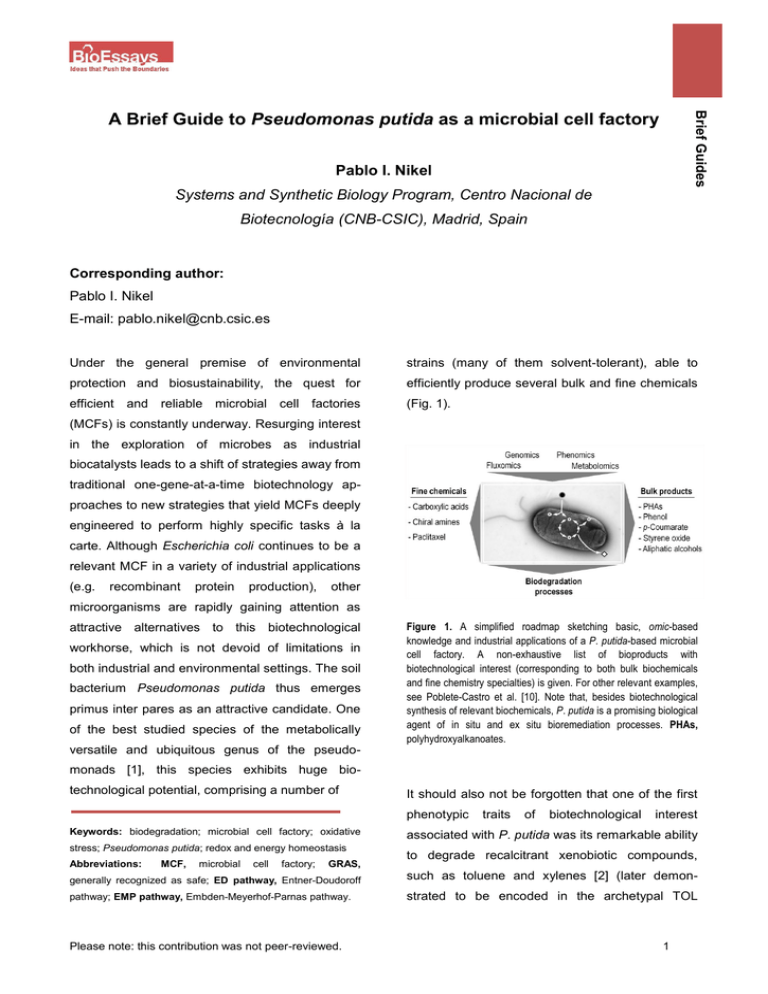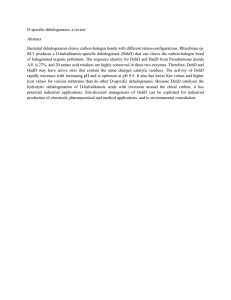A Brief Guide to Pseudomonas putida as a microbial cell
advertisement

Brief Guides A Brief Guide to Pseudomonas putida as a microbial cell factory Pablo I. Nikel Systems and Synthetic Biology Program, Centro Nacional de Biotecnología (CNB-CSIC), Madrid, Spain Corresponding author: Pablo I. Nikel E-mail: pablo.nikel@cnb.csic.es Under the general premise of environmental strains (many of them solvent-tolerant), able to protection and biosustainability, the quest for efficiently produce several bulk and fine chemicals efficient and reliable microbial cell factories (Fig. 1). (MCFs) is constantly underway. Resurging interest in the exploration of microbes as industrial biocatalysts leads to a shift of strategies away from traditional one-gene-at-a-time biotechnology approaches to new strategies that yield MCFs deeply engineered to perform highly specific tasks à la carte. Although Escherichia coli continues to be a relevant MCF in a variety of industrial applications (e.g. recombinant protein production), other microorganisms are rapidly gaining attention as attractive alternatives to this biotechnological workhorse, which is not devoid of limitations in both industrial and environmental settings. The soil bacterium Pseudomonas putida thus emerges primus inter pares as an attractive candidate. One of the best studied species of the metabolically Figure 1. A simplified roadmap sketching basic, omic-based knowledge and industrial applications of a P. putida-based microbial cell factory. A non-exhaustive list of bioproducts with biotechnological interest (corresponding to both bulk biochemicals and fine chemistry specialties) is given. For other relevant examples, see Poblete-Castro et al. [10]. Note that, besides biotechnological synthesis of relevant biochemicals, P. putida is a promising biological agent of in situ and ex situ bioremediation processes. PHAs, polyhydroxyalkanoates. versatile and ubiquitous genus of the pseudomonads [1], this species exhibits huge biotechnological potential, comprising a number of It should also not be forgotten that one of the first phenotypic Keywords: biodegradation; microbial cell factory; oxidative stress; Pseudomonas putida; redox and energy homeostasis Abbreviations: MCF, microbial cell factory; GRAS, traits of biotechnological interest associated with P. putida was its remarkable ability to degrade recalcitrant xenobiotic compounds, generally recognized as safe; ED pathway, Entner-Doudoroff such as toluene and xylenes [2] (later demon- pathway; EMP pathway, Embden-Meyerhof-Parnas pathway. strated to be encoded in the archetypal TOL Please note: this contribution was not peer-reviewed. 1 plasmid pWW0). These interesting features, along putida KT2440 has been elegantly exposed by with their entire lack of pathogenesis determinants Ebert et al. [4] by introducing systematic per- (P. putida KT2440, a plasmid-less derivative of the turbations in NADH and ATP demand. original P. putida isolate termed mt-2, has been Another hurdle that calls for attention is the given the GRAS status), high stress resistance, metabolic architecture of sugar catabolism in P. and amenability to profound genetic refactoring putida. Glucose is one of the most attractive and heterologous gene expression, make P. putida substrates to fuel the metabolism of micro- an ideal starting point in the search for superior organisms used in energy-dependent biopro- MCFs. Then, the relevant question that needs to cesses. The biochemical network of P. putida be addressed is: what are the current limits for the seems geared for the catabolism of a large variety wide biotechnological application of P. putida? And of substrates (e.g. organic acids) with a clear focus even more relevant, what needs to be done to on metabolic diversity rather than efficiency. P. overcome these limits? putida KT2440, like many other Pseudomonas Many of the potential P. putida-based applications species and rhizosymbionts, has an incomplete are still at an early stage of progress due to the Embden-Meyerhof-Parnas (EMP) pathway be- lack of knowledge on the genotype/phenotype cause of a missing 6-phospho-fructokinase [5]. relationships under conditions relevant for both The initial steps of glucose metabolism in this industrial and environmental endeavors. Recent bacterium occur through a set of three convergent advances in molecular biology tools, genome- pathways scale models, theoretical understanding, and gluconate, adding a further level of complexity to kinetic modeling of P. putida have increased the hexose catabolism. As glucose is catabolized interest in using targeted metabolic engineering almost entirely through the Entner-Doudoroff (ED) strategies to program this bacterium for bio- pathway, utilization of hexoses is not optimal from technological purposes. In particular, the complete the biotechnological point of view since it yields genomic sequencing of strain KT2440 [3] has half of the ATP obtained through a bona fide EMP provided its pathway. Most surprisingly, knocking out eda metabolic potential, opening avenues for several (encoding the second step of the ED pathway) and omics studies. However, the nub of the problem of expressing pfkA from E. coli (encoding the missing designing an improved MCF based on this bioreaction needed to sustain a complete EMP microorganism mostly resides in the difficulty of pathway) not only failed to activate an EMP partially or totally dissociating catabolism from metabolism, but also turned out to be detrimental anabolism, as needed in a suite of applications. to growth on different carbon sources, interfering When the aim is shifting its metabolic network with both the redox and energy balance [6]. This entirely towards the formation of a heterologous points to an evolutionary advantage of an ED- product, one should minimize by-product synthesis based metabolism, and also demonstrates the and cell growth. But, as it happens, the extant central role of catabolic pathways in P. putida metabolic properties of the cells, including redox (while posing quite a challenge to metabolic and energy homeostasis, often act in the opposite engineers!). As a corollary, it seems likely that way. The surprising – and somewhat annoying – environmental bacteria hosting an ED pathway robustness of the central metabolic pathways in P. over an EMP pathway do so to gear their aerobic diverse means of investigating Please note: this contribution was not peer-reviewed. that eventually yield 6-phospho- 2 metabolism for enduring oxidation-related insults nutritional resources (and starving the biocatalyst [7]. And, on this very subject, moving the window is not the brightest idea to harness its full of metabolic operativity of P. putida in terms of potential). With the continuous advent of new and oxygen availability towards more reduced environ- more sophisticated tools for genome manipulation, ments would also be a welcome industrial trait [8]. the design of a device that efficiently switches the cell state from growing conditions into the Finally, as reproduction can be regarded as a production status can be envisaged in the near seriously distractive (yet unavoidable) process future. from other cellular activities, it would be desirable From its humble beginning in the soil towards its to synthesize heterologous products in non- promising future as a fully programmable MCF, the growing cells. This strategy would allow efficient exciting trajectory of P. putida keeps offering room channeling of metabolic resources into the desired for improvement. The burgeoning field of systems product rather than into biomass (in this context, metabolic engineering, guided by recent advances an unwanted by-product). Despite many efforts, it in Synthetic Biology [9], will surely help to exploit is still enormously difficult to stop bacterial growth the maximum industrial potential of P. putida and without stressing the cells put it in the middle of the biotechnological arena. by limiting their Acknowledgements I am indebted to Prof. Víctor de Lorenzo for guiding me into the amazing world of metabolic engineering of Pseudomonas, and for inspiring discussions on the contents of this article. I would like to thank Esteban Martínez-García for sharing the P. putida micrograph used in the figure. The author is a researcher from the Consejo Nacional de Investigaciones Científicas y Tecnológicas (Argentina), and holds a Long-Term Fellowship from the European Molecular Biology Organization (EMBO ALTF 13-2010). References 1. 2. Timmis KN. 2002. Pseudomonas 5. putida: a cosmopolitan opportunist par excellence. identification Environ Microbiol 4: 779-81. metabolism in seven bacterial species. J Bacteriol Nakazawa T. 2002. Travels of a Pseudomonas, 187: 1581-90. from Japan around the world. Environ Microbiol 4: 3. 6. and quanti-fication of glucose Chavarría M, Nikel PI, Pérez-Pantoja D, de 782-6. Lorenzo V. 2012. The Entner-Doudoroff pathway Nelson KE, Weinel C, Paulsen IT, Dodson RJ, et empowers Pseudomonas putida KT2440 with a al. high tolerance to oxidative stress. Environ Microbiol, 2002. Complete genome sequence and comparative analysis of the metabolically versatile Pseudomonas putida KT2440. Environ Microbiol 4: 4. Fuhrer T, Fischer E, Sauer U. 2005. Experimental in press, DOI: 10.1111/1462-2920.12069. 7. Loza-Tavera H, de Lorenzo V. 2011. Microbial 799-808. bioremediation of chemical pollutants: how bacteria Ebert BE, Kurth F, Grund M, Blank LM, et al. cope with multi-stress environmental scenarios. In 2011. Response of Pseudomonas putida KT2440 to Storz increased NADH and ATP demand. Appl Environ responses. Washington, D.C.: ASM Press. p 481- Microbiol 77: 6597-605. 92. Please note: this contribution was not peer-reviewed. G, Hengge R, eds. Bacterial stress 3 8. 9. Nikel PI, de Lorenzo V. 2013. Engineering an 10. Poblete-Castro I, Becker J, Dohnt K, Martins dos anaerobic metabolic regime in Pseudomonas putida Santos VAP, et al. 2012. Industrial biotechnology of KT2440 for the anoxic biodegradation of 1,3- Pseudomonas putida and related species. Appl dichloroprop-1-ene. Metab Eng 15: 98-112. Microbiol Biotechnol 93: 2279-90. de Lorenzo V. 2008. Systems biology approaches to bioremediation. Curr Opin Biotechnol 19: 579-89. Please note: this contribution was not peer-reviewed. 4






